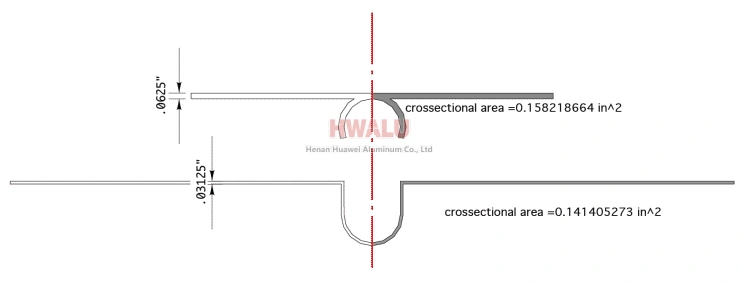The following finite element analysis (FEA) study results compare the efficiency of fins using thick extruded and thin stamped aluminum sheets. The parameters of this study are:
120°F water temperature in pipes, 70°F air temperature above and below floor assembly, 8″ pipe spacing, 1/2″ PEX, 2.0 Btu/hr/ft2/F, 8″ heat transfer coefficient x 1/32″ stamped plate and 4″ x 1/16″ extruded plate with non-destructive contact between fins and subfloor.
A note on the FEA study: The results reflect only a combination of the above parameters and the reader is advised not to draw conclusions based on parameters that have not been studied. These results should also not be indicative of transient conditions such as start-up, nor should they account for destructive contact (es decir. air gaps due to fin twisting and bending, an inherent property of thin plate systems). Furthermore, the model does not take into account 3D transport along the pipe, es decir. how much energy is extracted from the pipe along its length.
INFO: Any combination of parameters not studied will produce different results than the graph below. Furthermore, given the choice between slab and no slab, readers are told that slabless systems, especially systems where pipes are installed to the side of the joists or suspended in the air between the joists, are the least efficient for heating the floor. method. In the latter case, it’s akin to taking a pot of water off the stove and heating it up. In all but the warmest climates and/or the most efficient homes such as the R2000 or PassiveHaus, side-mounted or suspended or panelless systems can destroy boiler efficiency as ineffective installation methods require higher temperatures.
In addition to evaluating the use of heat transfer plates, users should also evaluate the sound amplification potential of the plates due to pipe expansion and contraction. Installation methods specific to aluminum pipe manufacturers should be followed to ensure a quiet and effective air-conditioned floor.

Figure 1. Profile of the extruded (top) and stamped (bottom) aluminum heat transfer plates used for sub-floor radiant cooling and heating systems.

Figure II. Graphical results of the study. Due to the increased contact area and conductivity, extruded plates provide higher surface temperatures from point b to b’ compared to thin fins. This represents a width of approximately 2.5 pulgadas. Near the edge of the extruded plate at c and c’, note the thermal degradation from point b to point c, point c to point d, point b’ to c’ and point c’ to d’. This is because profile 4″ (c to c’) is narrower than stamped profile 8″ (e to e’), where c to d and c’ to d’ represent the surface temperature of the unplated subfloor.
Note that, all other factors being equal, the higher peak temperature provided by the extruded plate also means a lower return fluid temperature, which improves boiler efficiency. Based on studies using the parameters described, extruded polystyrene is a good choice for narrower joist bays with higher resistance floors and where return flow temperature values are low. A more detailed study of the different combinations will provide further comparative results.

Figure 3. Assembly details for extruded 1/16″ x 4″ aluminum plate. Make note of the center line chain of conductance of tube, plate and wood. Con este perfil, la placa facilita la conductancia de la tubería en la madera de manera más efectiva que la placa estampada que se muestra en la Figura 5 y figura 6.

Figure 4. Isotermas pintadas a color del análisis de elementos finitos (FEA) para el extrusionado 1/16″ x 4″ aluminum plate. Tenga en cuenta la intensidad térmica alrededor de la placa extruida en comparación con la placa estampada que se muestra a continuación en la Figura 6. Este tipo de placa es más eficaz para extraer el calor de la tubería, lo que da como resultado temperaturas de retorno más bajas, lo que mejora la eficiencia de la caldera..

Figure 5. Assembly details for extruded 1/32″ x 8″ aluminum plate. Note the reduced area and conductivity at the centerline for this specific stamped plate, this results in the lower surface temperature (b to b’) shown in Figure 2 in comparison to point to the temperatures shown from a to b and a to b’.

Image 6. Colored isotherms of finite element analysis (FEA) of a stamped 1/32″ x 8″ aluminum plate. Due to the wider profile of the 8″ board, the heat distribution extends further outwards uniformly, but the overall board is less strong compared to the c to c’ of the extruded board, shown from e to e’ in Figure 2.
Comments: For this specific study, it can be demonstrated that both panels are effective at extracting heat from the PEX tubes and distributing it into the wood subfloor by conduction. As with many components, it’s not a question of one being better than the other, it’s a matter of looking at the application and choosing which is best for the task. Thicker extruded boards will be effective in narrower joist bays with higher resistance floor assemblies and wherever lower return temperatures are valuable, while thinner stamped boards will be effective in wider joists with lower resistance floors. Effective anywhere in the beam cavity and the lower return temperature is of no value relative to the capabilities of the extrusion type.
Whether thin stamping or thick extrusion, we do not recommend the type of ventilation fins that are fastened around the duct in a suspended duct system. The suspended pipe system is the least efficient of all options and cannot restore the lowest temperature to the heating system.
